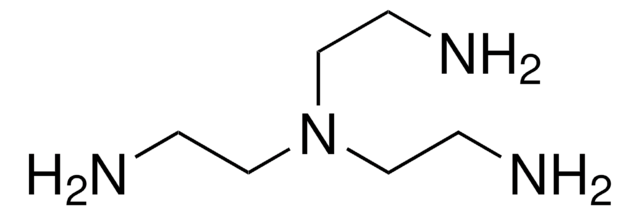Key Documents
188441
3,3′-Diamino-N-methyldipropylamine
96%
Synonim(y):
(7-Amino-4-methyl-4-azaheptyl)amine, 1,7-Diamino-4-aza(methyl)heptane, 1,7-Diamino-4-methyl-4-azaheptane
About This Item
Polecane produkty
ciśnienie pary
6 mmHg ( 110 °C)
Poziom jakości
Próba
96%
Postać
liquid
współczynnik refrakcji
n20/D 1.4725 (lit.)
tw
110-112 °C/6 mmHg (lit.)
gęstość
0.901 g/mL at 25 °C (lit.)
ciąg SMILES
CN(CCCN)CCCN
InChI
1S/C7H19N3/c1-10(6-2-4-8)7-3-5-9/h2-9H2,1H3
Klucz InChI
KMBPCQSCMCEPMU-UHFFFAOYSA-N
Zastosowanie
- new bischromone derivatives, potential anticancer drugs
- polyamine derivatives containing dimeric quinolone, cinnoline and phthalimide moieties
- 3-(2,4-dinitroanilino)-3′-amino-N-methyldipropylamine
Hasło ostrzegawcze
Danger
Zwroty wskazujące rodzaj zagrożenia
Zwroty wskazujące środki ostrożności
Klasyfikacja zagrożeń
Acute Tox. 1 Inhalation - Acute Tox. 3 Dermal - Acute Tox. 4 Oral - Eye Dam. 1 - Skin Corr. 1B
Kod klasy składowania
6.1A - Combustible acute toxic Cat. 1 and 2 / very toxic hazardous materials
Klasa zagrożenia wodnego (WGK)
WGK 1
Temperatura zapłonu (°F)
217.4 °F - closed cup
Temperatura zapłonu (°C)
103 °C - closed cup
Środki ochrony indywidualnej
Faceshields, Gloves, Goggles, type ABEK (EN14387) respirator filter
Wybierz jedną z najnowszych wersji:
Masz już ten produkt?
Dokumenty związane z niedawno zakupionymi produktami zostały zamieszczone w Bibliotece dokumentów.
Klienci oglądali również te produkty
Nasz zespół naukowców ma doświadczenie we wszystkich obszarach badań, w tym w naukach przyrodniczych, materiałoznawstwie, syntezie chemicznej, chromatografii, analityce i wielu innych dziedzinach.
Skontaktuj się z zespołem ds. pomocy technicznej


![Tris[2-(methylamino)ethyl]amine 97%](/deepweb/assets/sigmaaldrich/product/structures/217/368/3e89e134-669e-4a03-9a34-f97b50399bb2/640/3e89e134-669e-4a03-9a34-f97b50399bb2.png)


![Tris[2-(dimethylamino)ethyl]amine 97%](/deepweb/assets/sigmaaldrich/product/structures/695/792/ee0ff167-22a3-43a7-83a1-6c4908adf0ae/640/ee0ff167-22a3-43a7-83a1-6c4908adf0ae.png)




